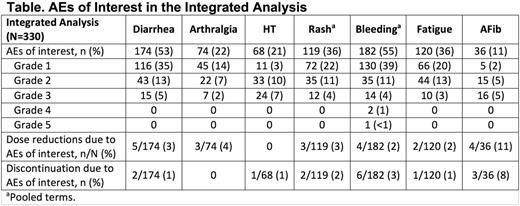Abstract
Background: Ibrutinib (ibr), a first-in-class, oral once-daily inhibitor of Bruton's tyrosine kinase, is indicated by the US FDA for the treatment of pts with CLL/SLL and allows for treatment without chemotherapy. Unlike chemotherapy that is given for a finite number of cycles, ibr is continued until progressive disease (PD) or unacceptable toxicity, leading to extended ibr treatment duration in many patients. The objective was to examine safety and tolerability of ibr therapy in pts with treatment-naïve (TN) or relapsed/refractory (R/R) CLL/SLL using an integrated safety analysis approach, and conduct an analysis of long-term safety.
Methods: In study PCYC-1112 (RESONATE), pts with R/R CLL/SLL received ibr 420 mg orally once-daily vs. ofatumumab (Byrd, N Engl J Med 2015). In study PCYC-1115 (RESONATE-2), pts age ≥65 years with TN CLL/SLL received ibr 420 mg orally once-daily vs. chlorambucil (Burger, N Engl J Med 2015). Progressing pts could enroll in the extension study PCYC-1116 for next line therapy (including ibr). Data from ibr-treated pts from the above randomized controlled studies were pooled for an integrated safety analysis. In study PCYC-1102, pts with TN or R/R CLL/SLL received ibr 420 mg or 840 mg orally once-daily (Byrd, N Engl J Med 2013; O'Brien, Lancet Oncol 2014). Pts could continue receiving ibr in the long-term extension study PCYC-1103 where adverse event (AE) collection was limited to grade ≥3 AEs, major hemorrhage, or AEs leading to ibr dose modification. Only data from pts treated with ibr 420 mg daily were examined herein.
Results: The integrated analysis included 330 pts; 51% Rai III/IV, 54% bulky disease ≥5 cm, 28% del11q, and 37% CrCl <60 mL/min. Pts received ibr for a median of 29.0 mo (max 42.9); 280 (85%) treated for >1 year, 193 (58%) for >2-3 years, and 53 (16%) for >3 years. Concomitant medications included 50% antiplatelet agents, 28% anticoagulants, 3% granulocyte growth factors, and 2% IVIG. The most common AEs were diarrhea (53%) and fatigue (36%). Other AEs experienced by ≥25% of pts were upper respiratory tract infection (30%), nausea (29%), pyrexia (28%), and anemia (27%). Grade ≥3 AEs reported in ≥5% of pts were neutropenia (18%), pneumonia (12%), anemia (7%), and hypertension (HT, 6%). AEs of interest were primarily grade 1/2 (Table). AEs of any grade that led to dose reductions and discontinuation were reported in 13% and 19% of pts, respectively. AEs leading to discontinuation in >1 pt were pneumonia (n=4), anemia (n=3), atrial fibrillation (AFib, n=3), diarrhea (n=2), subdural hematoma (n=2), and thrombocytopenia (n=2). 29 pts died (9%), the most common causes of death were PD (n=8), and pneumonia/lung infection (n=7). In PCYC-1102/1103, 94 pts were treated with ibr for a median of 47.9 mo (max 67.4 mo). The most frequent grade ≥3 AEs were similar to those observed in PCYC-1112 or PCYC-1115/1116, and at times, reflect higher cumulative rates given the median 19 additional months of treatment and follow-up; grade ≥3 AEs reported in ≥5% of pts were hypertension (30%), pneumonia (17%), neutropenia (15%) atrial fibrillation (11%), diarrhea (9%), cellulitis (7%), thrombocytopenia (7%), hyperglycemia (7%), fatigue (6%), decrease in lymphocyte count (6%), and sepsis (5%). Most frequent malignancies included basal cell carcinoma (n=4), squamous cell carcinoma (n=4), and myelodysplastic syndromes (n=2). In 7 of 15 pts, the malignancy AE was diagnosed during the first year, while others occurred over time throughout the ongoing follow-up of >4 years. Overall survival for R/R pts was 74% at 36 mo in PCYC-1112, and 62% at 60 mo in PCYC-1102/1103. Survival of TN pts was 95% at 24 mo in PCYC-1115/1116, and 91% at 60 mo in PCYC-1102/1103 (Kaplan-Meier estimates).
Conclusions: In these analyses, which included up to 5 years of follow up in TN and R/R CLL treated with single agent ibr, AEs were primarily grade 1/2 and were manageable with prolonged treatment.
Coutre:Janssen: Consultancy; Pharmacylics, LLC, an AbbVie Company: Consultancy, Research Funding; AbbVie: Research Funding. Hillmen:Pharmacyclics: Research Funding; Janssen: Honoraria, Research Funding; Roche: Honoraria, Research Funding; Gilead: Honoraria, Research Funding; Abbvie: Research Funding. Barr:Pharmacyclics LLC, an AbbVie Company: Consultancy, Research Funding; AbbVie: Consultancy. Devereux:Roche: Consultancy, Other: Travel, Accommodations, Expenses ; Gilead: Consultancy, Other: Travel, Accommodations, Expenses, Speakers Bureau; Janssen: Consultancy, Other: Travel, Accommodations, Expenses, Speakers Bureau; GSK: Consultancy. Robak:Pharmacyclics, LLC, an AbbVie Company: Consultancy, Honoraria, Research Funding; AbbVie: Consultancy, Honoraria, Research Funding; Janssen: Consultancy, Honoraria, Research Funding. Kipps:Celgene: Consultancy, Honoraria, Research Funding; Roche: Consultancy, Honoraria; Gilead: Consultancy, Honoraria, Speakers Bureau; AbbVie: Consultancy, Honoraria, Research Funding; Pharmacyclics, LLC, an AbbVie Company: Consultancy, Honoraria. Schuh:Roche: Consultancy, Honoraria; GSK: Consultancy, Honoraria; AbbVie: Consultancy, Honoraria; Novartis: Consultancy, Honoraria; Janssen: Consultancy, Honoraria; Gilead: Consultancy, Honoraria. Furman:Genentech: Consultancy; Janssen: Consultancy; Abbvie: Consultancy, Honoraria; Gilead Sciences: Consultancy; Pharmacyclics: Consultancy, Speakers Bureau. Burger:Janssen: Consultancy, Other: Travel, Accommodations, Expenses; Roche: Other: Travel, Accommodations, Expenses; Gilead: Research Funding; Pharmacyclics, LLC, an AbbVie Company: Research Funding; Portola: Consultancy. O'Dwyer:Roche: Other: Travel, accommodations, expenses; Novartis: Consultancy; Glycomimetics: Consultancy; Amgen: Consultancy, Other: Travel, Accommodations, Expenses ; BMS: Honoraria; Janssen: Consultancy, Honoraria, Research Funding; Celgene: Consultancy, Equity Ownership, Honoraria, Research Funding; NUI Galway: Patents & Royalties. Ghia:Abbvie: Consultancy, Honoraria; Adaptive: Consultancy; Gilead: Consultancy, Honoraria, Research Funding, Speakers Bureau; Janssen: Consultancy, Honoraria, Speakers Bureau; Roche: Honoraria, Research Funding. Valentino:Gilead: Equity Ownership; Pharmacyclics, LLC, an AbbVie Company: Employment, Other: Travel, accommodations, and expenses; AbbVie: Equity Ownership; Corvus: Equity Ownership; Johnson and Johnson: Equity Ownership, Other: Travel, accommodations, and expenses. Suzuki:AbbVie: Equity Ownership; Pharmacyclics, LLC, an AbbVie Company: Employment, Other: Leadership; Travel, Accommodations, Expenses. Ninomoto:AbbVie: Equity Ownership; Pharmacyclics, LLC, an AbbVie Company: Employment; Amgen: Equity Ownership. James:AbbVie: Equity Ownership; Pharmacyclics, LLC, an AbbVie Company: Employment. O'Brien:Janssen: Consultancy, Honoraria; Pharmacyclics, LLC, an AbbVie Company: Consultancy, Honoraria, Research Funding.
Author notes
Asterisk with author names denotes non-ASH members.


